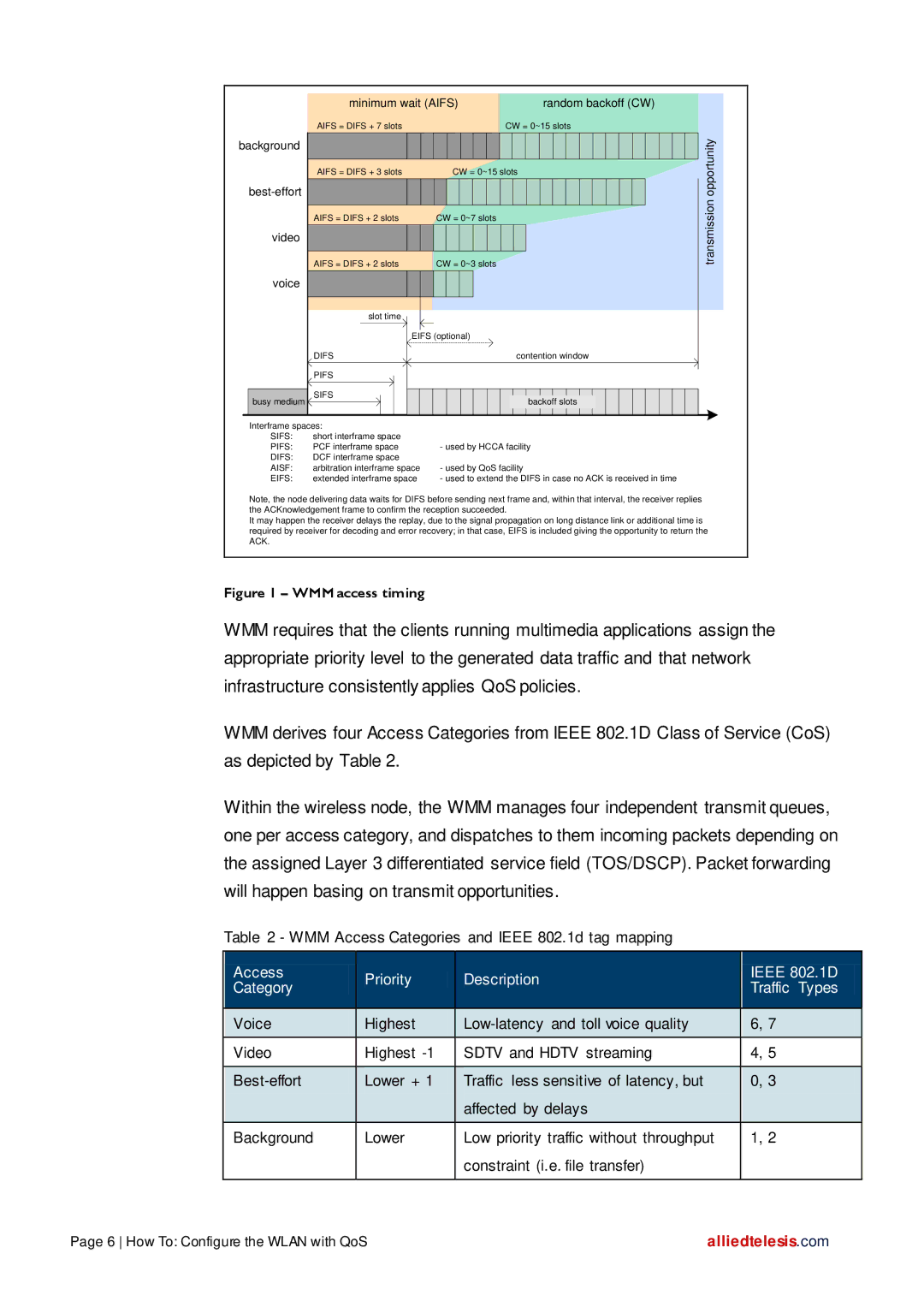
minimum wait (AIFS) | random backoff (CW) |
AIFS = DIFS + 7 slots | CW = 0~15 slots |
background |
|
| opportunity |
| AIFS = DIFS + 3 slots | CW = 0~15 slots | |
|
| ||
| AIFS = DIFS + 2 slots | CW = 0~7 slots | transmission |
video |
|
| |
| AIFS = DIFS + 2 slots | CW = 0~3 slots | |
|
| ||
voice |
|
|
|
| slot time |
|
|
|
| EIFS (optional) |
|
| DIFS | contention window |
|
| PIFS |
|
|
busy medium | SIFS | backoff slots |
|
|
|
Interframe spaces: |
| |
SIFS: | short interframe space |
|
PIFS: | PCF interframe space | - used by HCCA facility |
DIFS: | DCF interframe space |
|
AISF: | arbitration interframe space | - used by QoS facility |
EIFS: | extended interframe space | - used to extend the DIFS in case no ACK is received in time |
Note, the node delivering data waits for DIFS before sending next frame and, within that interval, the receiver replies the ACKnowledgement frame to confirm the reception succeeded.
It may happen the receiver delays the replay, due to the signal propagation on long distance link or additional time is required by receiver for decoding and error recovery; in that case, EIFS is included giving the opportunity to return the ACK.
Figure 1 – WMM access timing
WMM requires that the clients running multimedia applications assign the appropriate priority level to the generated data traffic and that network infrastructure consistently applies QoS policies.
WMM derives four Access Categories from IEEE 802.1D Class of Service (CoS) as depicted by Table 2.
Within the wireless node, the WMM manages four independent transmit queues, one per access category, and dispatches to them incoming packets depending on the assigned Layer 3 differentiated service field (TOS/DSCP). Packet forwarding will happen basing on transmit opportunities.
Table 2 - WMM Access Categories and IEEE 802.1d tag mapping
|
|
|
|
|
|
|
|
|
|
|
|
|
|
|
| Access |
|
|
|
|
|
|
|
|
| IEEE 802.1D |
|
|
|
|
| Priority |
|
| Description |
|
| ||||
|
| Category |
|
|
|
|
|
|
| Traffic Types |
| ||
|
|
|
|
|
|
|
|
|
|
|
| ||
|
|
|
|
|
|
|
|
|
|
|
|
| |
|
| Voice |
|
| Highest |
|
|
|
|
| 6, 7 |
| |
|
|
|
|
|
|
|
|
|
|
|
|
|
|
| Video |
| Highest |
| SDTV and HDTV streaming |
| 4, 5 |
| |||||
|
|
|
|
|
|
|
|
| |||||
|
|
|
| Lower + 1 |
|
| Traffic less sensitive of latency, but |
|
|
| 0, 3 |
| |
|
|
|
|
|
|
|
|
|
|
|
|
|
|
|
|
|
|
|
|
|
| affected by delays |
|
|
|
|
|
|
|
|
|
|
|
|
|
|
| ||||
| Background |
| Lower |
| Low priority traffic without throughput |
| 1, 2 |
| |||||
|
|
|
|
|
|
|
| constraint (i.e. file transfer) |
|
|
|
| |
|
|
|
|
|
| ||||||||
Page 6 How To: Configure the WLAN with QoS |
| alliedtelesis.com | |||||||||||
